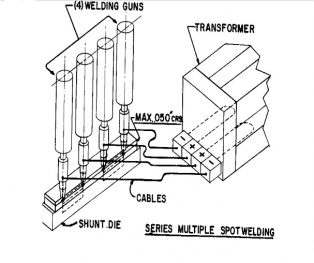
Controls & Transformers
Questions and Answers
If a process has been running successfully for some time and one suddenly losses the desired nugget, one of two things has occurred. A process variable has changed or the process was operating on the edge of the weld window. If this has been a long term good process, then process variables are the most likely suspects.
Process variables are anything which can affect the amount of current or the heat being generated. One should look at the variables that control pressure, current and time. Has your part changed? Is the forming of the part different and requiring more force to bring the two surfaces together? Has the cylinder or servo begun to stick or become sluggish? Have you tested the pressure? Is there sufficient plant air pressure and flow, all day? Is the plant power sufficient and consistent all day? Is there sufficient squeeze time to close the electrodes and reach full pressure? Do the electrodes need dressing? Are all electrical connections tight and clean? Have the shunts or cables worn? Some of these are wear items. Any one of these items can cause a change in weld performance.
Other individual articles describe these topics.
Go back to the basics. Check the current process against the original setup documents.
The secondary will short to ground because the secondary should be grounded. A possible failure mode is a short between the secondary and the primary. This indicates a failure of the insulation layer between these two windings. This failure can be caused by many reasons related to heat, condensation and other factors, to be discussed in another article. The transformer, welder, control and secondary should all be grounded which should take out the main breakers to the machine and protect the machine and personnel. The cause for this electrical short has been covered completely in another article which can be read separately:
Why Did the Resistance Welding Transformer Short Out Between the Primary and Secondary
For AC welding it is important to operate at a relatively high percent heat. This gives you the maximum efficiency and minimum off time during each weld cycle of the sine wave. So your weld schedule should be designed to optimize this situation as opposed to a high tap and a low setting where a large percentage of the time (each cycle) there is no current flow and the weld is actually cooling down.
Yes, it is a series weld. The weld guns are all arranged on one side of the part with the lower side being a fixed platen shunt die. Current flows through one wire joint into the lower shunt die to the next wire joint through that joint and back to the next gun to the transformer. This completes the circuit and the projection weld is complete. A series of many welds happen sequentially and the machine indexes to the next group.
Series welds do have shunting currents as shown in the sketch below. The transformer is attached to weld guns both on the same side of the part and the current must flow through the shunting die or part to return to the transformer. Some amount of current will flow across the top sheet unless this distance is large which would increase the resistance and retard this flow. Any current flow in the top sheet is wasted current "shunting current" that does not contribute to the weld nugget. This type of tooling arrangement is used when access to the underside of the part is restricted.

Page 16 of 39
Have a Question?
Do you have a question that is not covered in our knowledgebase? Do you have questions regarding the above article? Click here to ask the professor.
